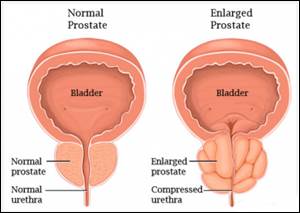Benign prostatic hyperplasia (BPH) is an enlarged prostate. The prostate goes through two main growth periods as a man ages. The first occurs early in puberty, when the prostate doubles in size. The second phase of growth begins around age 25 and continues during most of a man's life. As you age, your prostate may get larger. Benign prostatic hyperplasia often occurs with the second growth phase.
As the prostate enlarges, it can then squeeze down on your urethra. The bladder wall becomes thicker. Eventually, the bladder may weaken and lose the ability to empty completely, leaving some urine in the bladder. The narrowing of the urethra and urinary retention--the inability to empty the bladder completely--cause many of the problems associated with benign prostatic hyperplasia. BPH is benign. This means it is not cancer. It does not cause nor lead to cancer. But BPH and cancer can happen at the same time.
BPH is common in aging men. About half of all men between the ages of 51 and 60 have BPH. Up to 90% of men over age 80 have BPH.
The Prostate
The prostate is part of the male reproductive system. It is about the size of a walnut and weighs about an ounce. The prostate is below the bladder and in front of the rectum. The prostate goes all the way around a tube called the urethra. The urethra carries urine from the bladder out through the penis. The main job of the prostate is to make fluid for semen. During ejaculation, sperm made in the testicles moves to the urethra. At the same time, fluid from the prostate and the seminal vesicles also moves into the urethra. This mixture-semen-goes through the urethra and out the penis.



 Contact Us
Contact Us







 Hospitals
Hospitals
 Doctors
Doctors
 Diagnostic
Diagnostic
 Pharmacy
Pharmacy
 Health Tips
Health Tips
 Blog
Blog

























Comments